Combined flooring in the kitchen. What floors are better to do in the kitchen - an overview of modern flooring for the kitchen
Choosing the right flooring for your kitchen is a top priority. And here it is better to extend sympathy not to beauty, but to practicality. Ideal floors for the kitchen should be moisture resistant, durable, easy to clean, fit into the overall environment.
Let's figure out together which floor is better to do in the kitchen, because the modern construction market offers a lot of options. And then we will consider the most suitable of them.
Floor for the kitchen - which is better?
Most often as a floor covering in the kitchen can be found linoleum. It is resistant to abrasion, easy to clean, it does not break dropped dishes. In addition, it is easy to lay, and it costs relatively little. And thanks to the huge assortment of colors and textures, you can always realize any design idea and make your kitchen unique.
Another popular item is ceramic tile. It is very practical for the kitchen, because it has a durable surface, is not subject to abrasion, is not afraid of household chemicals, and does not absorb moisture and odors at all. Disadvantages include slipping on wet tile floors, cold surfaces, and the fact that a dropped plate is likely to shatter into small pieces.
wooden floors in the kitchen may seem impractical for the kitchen, but if you choose hardwood, you don’t have to worry about the durability of the floors. The best option would be parquet or thermowood tile - it is absolutely not afraid of moisture and high temperature.
Often the answer to the question - which floor is better to do in the kitchen, becomes. It is cheaper than parquet, while it has most of its properties: it is warm, looks natural and beautiful. Just try to protect it from moisture - it will deform from it.
It is not widespread enough, but this is more likely due to the prejudice in its insufficient strength. In fact, the cork is not at all afraid of moisture, does not warp or swell. At the same time, the cork floor is soft and warm.
What color is better to lay the floor in the kitchen?
Undoubtedly, the dark floor is more practical. However, you need to start from the general style of the room. Contrasting floors look good: light furniture and darker flooring.
The most common in kitchens are gray, orange, beige shades. Not bad if the interior has details that repeat this color. Then the picture is more harmonious and complete.
The kitchen floor is subject to the most wear and tear of all the rooms in a house or apartment. The owners want the floor in the kitchen to be easy to clean, so that the floor is resistant to damage, not afraid of spilled water, oil or grease. It is not so easy to decide which floor is better to make in the kitchen so that it meets all the requirements at once. So let's try to figure out what you need to pay attention to when equipping the floor.
Before you make a floor, you need to make sure of a few things, firstly, think about how the interior design of the room and the future floor are combined. Secondly, you should check whether the base is ready for the floor, which should be perfectly flat and horizontal, you may have to redo the screed.
This is important, the quality of the base depends on the duration of the floor itself, so in case of uncertainty, it is better to consult an expert.
In addition, there may be technological limitations, for example, if you intend to equip the kitchen with underfloor heating, you should also use an appropriate floor covering with high thermal conductivity. In this case, it is better to choose a coating from the options recommended by experts for each situation.
If the kitchen is large or combined with a room, they practice such a solution as a combination of floor coverings of several varieties. For example, in working area lay porcelain stoneware or tiles, and in the dining area make a laminate floor or lay linoleum. If the kitchen area is small, then it is wiser to use the same material for the entire floor, preferably a solid color.
Ceramic tile
Among the varieties of kitchen flooring, tile is the most popular option. Affordable, ceramic tiles have beauty that is durable, and as a coating, tiles are very practical to use. This material is not afraid of moisture, absolutely clean from the point of view of ecology, resistant to sunlight and various liquids.

In addition, due to the variety of patterns or ornaments, a large color scheme, you can choose exactly the right tile for any design designed for the kitchen. Various patterns are often laid out from tiles of several colors.

There are several basic installation methods. ceramic tiles: in a run, butt-to-butt, diagonally. You can also combine all these methods. It should be noted that the tile also has disadvantages, the most significant: the tile is cold, such a floor will have to be covered with a rug or a heated floor should be installed in the kitchen.

Where the hostess works, it is better to lay tiles with a matte finish, with a relief surface, your feet slide much less on such tiles, thereby you will protect yourself from the danger of falling on a slippery floor and getting injured. For the kitchen, it is recommended to lay wear-resistant tiles on the floor (wear resistance class 3-4, hardness class 4-5).
The artificial material porcelain stoneware is known to specialists for a number of advantages. Due to the ability to withstand extreme temperatures, strength, moisture resistance and high hardness (hardness grade 8-9), porcelain stoneware looks like the perfect flooring for the kitchen.

If you choose from varieties of porcelain stoneware, then for the kitchen it is preferable to take polished tiles rather than matte ones.
Self-leveling floors
Polymer self-leveling floor (the so-called liquid linoleum), spreading over the surface of the screed and after curing forming an excellent coating. This floor has a spectacular look, smooth, shiny, you can choose from dozens of color options. But they also make fantastic-looking self-leveling floors with a three-dimensional pattern. In such a 3D floor, beautiful paintings, photographs or decorative elements (plastic, metal, wooden inserts) are used.
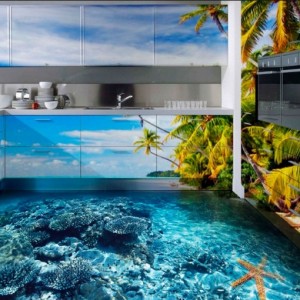
The advantage of such a floor is moisture resistance, high resistance to mechanical damage and wear resistance. But you should keep in mind that such a floor is glued to the screed “tightly” and changing or removing this coating will be a big problem.
Concrete floor
Waxed concrete flooring is something ultra-modern, urban. Making such a floor is one of the examples of high-tech design. Naturally, in terms of strength and durability, this flooring is ideal. But the concrete floor is cold and very heavy, so you need to consider how much weight to add to the load on bearing structures building.
Linoleum in the kitchen
A very common flooring option that people think about when deciding which floor to make in the kitchen is linoleum. Both natural and synthetic linoleum is practical to use, and artificial linoleum, with its excellent performance, is also inexpensive.
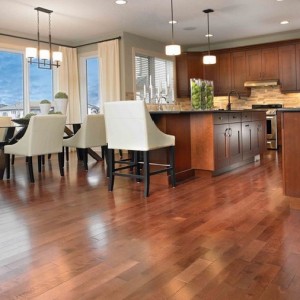
Modern linoleum has gone far from the old Soviet samples, the times of the USSR. This is a beautiful and durable polymer material, with high sound and heat insulation, which will last at least ten years without any problems. Best for kitchen semi-commercial linoleum- it has a thicker protective layer, which means it is more durable.
Linoleum on the floor in the kitchen is good for everyone, it is easy to lay even on your own, it is easy to clean and does not need special care. Thanks to a large number colors, patterns, linoleum patterns, you are in no way limited in your search for kitchen design options. There is linoleum for wood, parquet, leather, stone and with abstract patterns.

But keep in mind that synthetic linoleum is not always safe for health. In order not to spoil the environment in the room, avoid buying cheap linoleum sold in the markets. Linoleum with a large amount of harmful impurities produces a strong unpleasant odor from the roll.
There are types of linoleum that cannot be used in residential premises. Therefore, carefully read the contents of the markings on the linoleum and labels. It says where you can use this linoleum. The safety for human health of the brands artoleum, marmoleum and other expensive linoleums is reliably known.
Although cork flooring is a novelty for consumers in Russia, many supporters of natural finishing materials have already appreciated this flooring. With a frequency of several years, the cork oak bark is cut off and a wonderful coating is made from it, very comfortable, elastic, protecting your spine when walking.

Cork floor is a warm floor, non-slip, soundproof and resistant to dust and stains, for rooms where there are asthmatics or people with allergies, cork is optimal.
It is widely believed that this material is very useful for the human body. In addition, cork looks great in almost any interior, thanks to a variety of shades and textures. So that the cork floor is not afraid of moisture, it is coated with a special varnish before use.
Wooden floor and parquet in the kitchen
Natural wood floor coverings, whether it is parquet or wooden flooring, although expensive, are the most luxurious. A kitchen with such a floor will look very respectable. This floor goes well with different interior styles. However, wood is vulnerable to moisture and temperature, so these floors are more suitable for a dining or dining area than a work area.
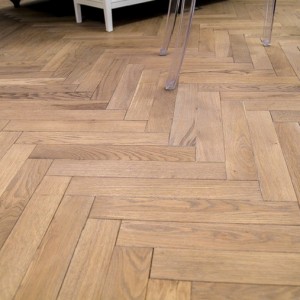
With the help of special impregnations and special varnishes, wooden floors are strengthened and made resistant to moisture, dust and mechanical damage.
In addition to the need for constant care, the disadvantage of wooden floors is the high cost of both the main material and additional materials and treatment and care products.
If your budget allows for these costs, you will get a floor that is ideal in terms of ecology and rich in design possibilities.
Use of laminate flooring in the kitchen
acceptable alternative wooden floor is a laminate flooring. It is inferior to wood in terms of ecology, but it is significantly cheaper. The advantages of this coating include ease of installation, low flammability, resistance to stress and mechanical stress.
It is important that the laminate can be laid on an equipped warm floor. This coating is available with a large number of patterns, wood, marble, tile or natural stone. The disadvantage of this material is low moisture resistance. Therefore, even if you bought a waterproof option, anyway, take care of waterproofing during installation.
Buy material from reputable sellers, long known in the market building materials. Do not forget to check for which premises this type of laminate is specifically intended, and do not hesitate to ask the seller for product certificates: conformity and hygienic.

Thus, in the process of choosing which floor is best for the kitchen, you will have to find a balance between two groups of factors. On the one hand - beauty and naturalness, and on the other - strength and durability. Although flooring manufacturers themselves strive to offer the best combination of these important qualities.
The choice of flooring in the kitchen is often confusing.
The specificity of the room is that the floors can be subjected to various aggressive influences.
This means that not every material that you like, or can afford, is considered suitable.
Let's review the building materials that are used to make the floor in the kitchen. What is better to put on the floor in the kitchen.
Water resistance
Not only in the bathroom, water gets on the floors. It is everywhere here: from small drops when washing dishes and fumes while boiling a kettle, to accidentally spilled soup and regular wet cleaning. Therefore, all materials here must be used resistant to moisture!
Wear resistance and hygiene
The physical abrasion of areas near tables, sinks, refrigerators is huge! There are always people here. But abrasion is not the only load:
- The coating can be cleaned with abrasive substances during cleaning;
- Heavy, sharp, hot objects can fall on it;
- Constant pressure from the legs of the table and chairs is a serious test of strength;
- Fats and acids are present here, which means that there is a risk of contact with them;
- Chemical detergents should also not harm the material;
- Temperature differences throughout the room also affect the floor;
- The risk of fire must also be taken into account.
Well, of course, the floor in the kitchen should be pleasing to the eye and be comfortable for the person. If it is cold to stand on it or slip easily, all other virtues will fade.
 Sheathing a house is needed not only in order to restore the appearance of a dilapidated building. It gives even a new building a complete look. - the choice of material depending on the design of the house.
Sheathing a house is needed not only in order to restore the appearance of a dilapidated building. It gives even a new building a complete look. - the choice of material depending on the design of the house.
Thermal insulation materials for warming the house from the inside are presented in the review.
The calculation of the area of the premises is always necessary in the repair and construction. It's all about how to calculate correctly square meters in standard and non-standard rooms.
Varieties of flooring for the kitchen
Now more about each option.
Tiles, ceramics
A very popular option because it meets most requirements.
The tile does not get dirty, it is easy to clean, it does not scuff, it does not show dents from furniture legs, it is resistant to chemicals, fats and does not burn. In addition, today tiles are produced in huge quantities and you can always choose what you like and decorate the interior.
There are also disadvantages and difficulties with tiles:
- It's hard to put it on. You will need professional skills.
- Hard but brittle surface. Glassware or a phone that falls on a tile is likely to break. But if a heavy object falls, it can crack the tile itself. Also at the installation stage, ceramics must be handled with care.
- Slippery gloss. The tile itself is not too slippery, but if liquid or oil gets on it, this makes the coating very traumatic. This is especially true for families with children and the elderly.
- The cold surface is not liked by those who like to walk barefoot and families with kids.
- It costs expensive. Tiles are above average materials.

Tiles on the floor in the kitchen
If, in general, the tile suits and there are funds for its purchase and installation, you can smooth out the “cold” disadvantage by making warm floors (water or electric) in the kitchen.
Porcelain stoneware
Similar in characteristics to a tile. It also repels water, is easy to clean, does not wear out, is durable and fire retardant.
But at the same time, porcelain stoneware is more durable itself (it is not so easy to break it during transportation or with a heavy object), it imitates natural stone. However, with all the same disadvantages (cold, difficult to install, slippery, hard), porcelain stoneware is more expensive.
Linoleum
Also a leader among kitchen flooring. Cheaper and warmer than tile, and easier to install. Washes well, provides a wide range of colors and textures. Linoleums of the new generation on a dense basis are not as cold as before, they are more resistant to abrasion and punching by the legs. So that the linoleum does not look messy, the base must be perfectly flat.
But there are still disadvantages:
- Not natural material.
- Fire hazardous.
- Inexpensive thin samples break through, burn out in the sun, wear out.
- May be damaged by household chemicals.
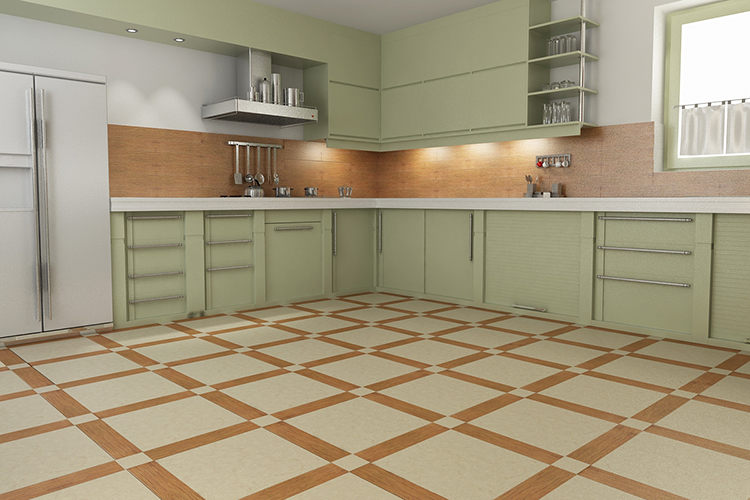
Linoleum in the kitchen
When purchasing linoleum, learn about its varieties. Manufacturers are working to fix the deficiencies. For example, the top layer is thickened, increasing wear resistance, or impregnations are used that reduce the fire hazard.
Laminate
A solid look for little money - this formula has made laminate another kitchen leader. The material is easy to clean, warm, imitates natural wood, which looks good, but is not very suitable for the kitchen (see below). So that the elements do not creak or break through, the surface of the base is carefully leveled.
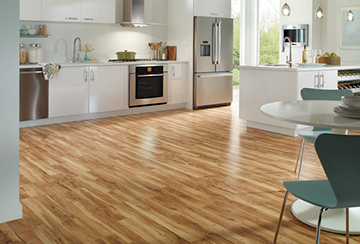 Minuses:
Minuses:
- Not natural.
- The base of MDF or chipboard is not moisture resistant.
- Requires special styling skills.
- Requires censorship of detergents.
Ask for a moisture-resistant laminate grade. It will last longer also because it is more durable.
Cork
If you handle the coating with extreme care, you can find many positive properties in the material: the cork is warm and pleasant (even a little soft). It does not swell, is not afraid of moisture. Does not slip and does not support combustion.
- Cork is afraid of fat.
- You can't call it durable.
- It is necessary to protect from sharp objects, pressing chairs.
- The price bites.
For the kitchen, only glue-based cork is chosen, it is it that is moisture resistant. Particular attention to the alignment of the base.
Self-leveling floors
Very durable and wear resistant. He does not care about water, fire, sun, chemicals, furniture legs and falling objects! It is easy to wash and clean. There are no joints where dirt can clog.
Moreover, it is the most the best option if design ideas are in full swing, looking for embodiment. You can even create 3D images.
Disadvantages: high price.
Installation is usually trusted by specialists, but if you wish, you can also master the technology yourself.
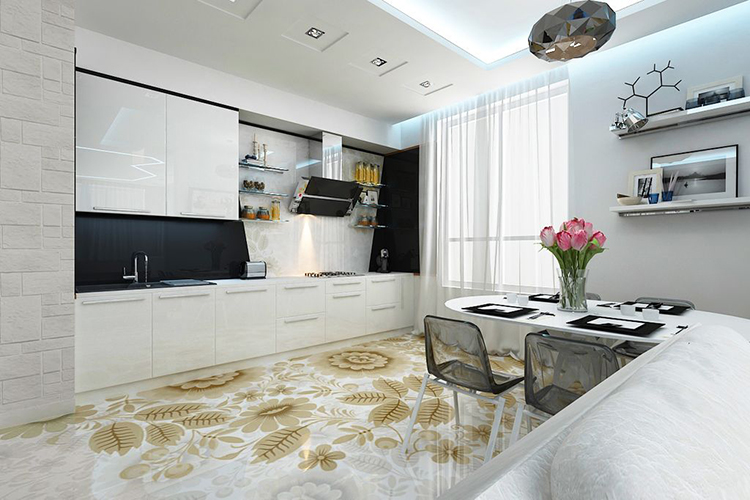
Self-leveling floor in design
Impractical Options
From the attractive sides - softness and warmth, a cozy look. Average price. Carpet does not need to be glued. It can be fixed with skirting boards and changed as often as the budget allows.
Natural tree. Wood is not a moisture resistant material. Natural such a coating can be called conditionally, since the surface is never left untreated. And impregnations and paints will still be synthetic materials.
By the way, the need to constantly update, tint - also refers to the disadvantages (scuffed stripes near the stove and sink quickly appear and look sloppy, and you have to repaint the entire surface).
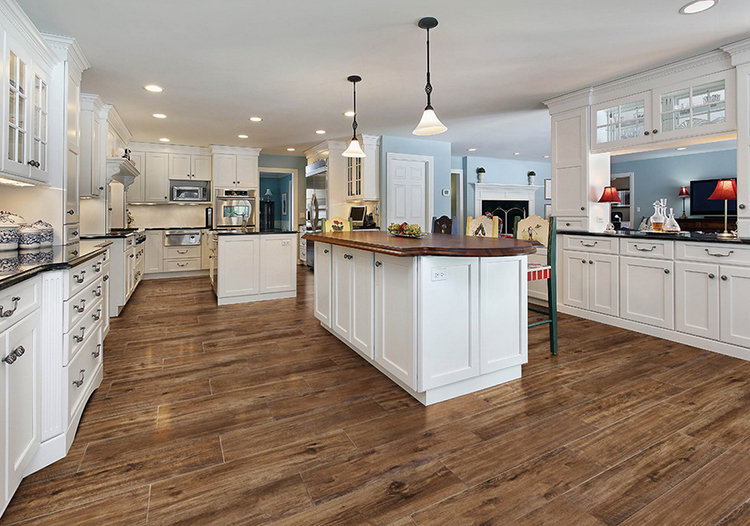
Parquet flooring
If you really want wood, pay attention to the double-sided parquet, which is not even afraid of flooding.
So what is the best kitchen floor? The modest size of the kitchen is a popular problem in our country. Drawing on the floor can visually expand the space, or vice versa, steal it even more.
Remember a simple rule: the larger the tile, or the pattern on the linoleum (or other details), the smaller the room will seem. If you need to visually enlarge the kitchen, choose textures with a small pattern.
Boards of parquet, laminate and wood imitators pull the room in the direction where these boards are directed.
What floor color to choose for the kitchen. Warm shades are preferable because they make the room warmer, neater and cozier. Cold tones make the room strict, not residential, cause feelings of laziness, apathy and not hospitality.

Kitchen interior with tiled floor
The optimal solution is a combination of floors
If the size of the kitchen allows you to divide it into zones (dining and working), then a combination of two materials would be an excellent solution:
- For the working part, the most durable coating is suitable (tile, porcelain stoneware or self-leveling floor).
- And for the dining area, it’s already what the soul and legs want (carpet, cork, parquet, etc.).
Summing up
So what to consider:- With a modest budget choose linoleum.
- It is also optimal if children scurry about in the kitchen.
- Older people will be pleased and safe to walk through the traffic jam.
- If it is possible to make a system of underfloor heating, then porcelain stoneware would be an excellent option, but tiles can also be used.
- Laminate is chosen when linoleum is tired.
- And self-leveling floors are just a chic option that requires a lot of money.
In any case, rely not on fashion trends or prestige, but on your feelings and sense of taste.
 A bath is a room that is not heated regularly, and in extreme cold it becomes difficult to heat it. An excellent exit - a heat-insulated floor. To be comfortable in the bath all year round, need to know, . Consider electric and water options.
A bath is a room that is not heated regularly, and in extreme cold it becomes difficult to heat it. An excellent exit - a heat-insulated floor. To be comfortable in the bath all year round, need to know, . Consider electric and water options.
About the organization of ventilation in frame house read the link. Kinds ventilation systems and organization in practice.
Related video
The kitchen is a place in the house where someone is constantly present and there are various unfavorable factors (greasy splashes, high temperature and humidity ...). Therefore, the floor must be chosen the most stable and durable. Let us consider in more detail the options for flooring for the kitchen and their features.
What factors to build on when choosing a floor for the kitchen?
When choosing a floor covering in the kitchen, it is necessary to decide for what purposes it is intended, and only then pay attention to the following factors:
The floor in the kitchen should have the following properties:
- Water resistance. The kitchen is one of the leading rooms in a home exposed to water.
- hygiene. The floor in this room should be easy to clean from grease. In the absence of this quality, the flooring will be regularly exposed to aggressive detergents, due to which the floor will last a much shorter service life.
- impact resistance- the dishes are quite heavy and may damage the coating upon impact.
- wear resistance- regular movement does not affect in the best way for the duration of service.
Designers' recommendations for choosing flooring for the kitchen
The floor covering must be perfect fit the style and design kitchen room. Below are a couple of design tips to help make a room feel cozier:

Types of flooring for the kitchen
There are a variety of floor coverings on the market today.
Ceramic tiles and porcelain tiles
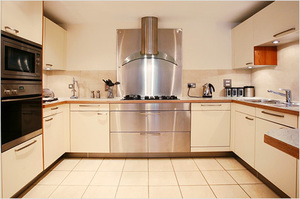 Ceramic tiles are made from natural materials. Does not fade under the rays of the sun and is quite easy to care for - it will be enough to wash as it gets dirty. Not afraid of hard brushes and aggressive cleaners. The most common inexpensive coating, which has such properties as practicality and convenience.
Ceramic tiles are made from natural materials. Does not fade under the rays of the sun and is quite easy to care for - it will be enough to wash as it gets dirty. Not afraid of hard brushes and aggressive cleaners. The most common inexpensive coating, which has such properties as practicality and convenience.
This coating is quite easy to fit into any style of the room, as it has a different texture and pattern. To shortcomings can be attributed low thermal conductivity so you have to lay a rug on top or make floor heating.
best kitchen tiles matte or embossed to prevent slipping on it.
Laying can be done in such ways as:
- "butt butt";
- "on the run";
- "diagonally";
- various combinations of materials listed above.
With proper care, this coating will last for decades.
Porcelain tile is made from artificial materials. Resistant to external adverse factors - waterproof, not afraid of temperature changes. Care and installation is carried out, as well as for ceramic tiles. Imitates various natural materials. For safety reasons, it is necessary to take matte tiles for the kitchen covering. Has a low price and long service life.
self-leveling floor
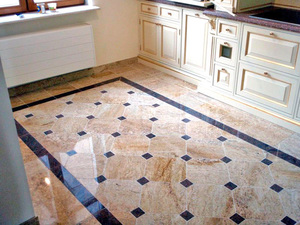 Bulk floor - a novelty in the market of a floor covering. Made from polyurethane. Resistant to external adverse qualities, easy to care for and has a low price. With proper installation, it will last quite a long time.
Bulk floor - a novelty in the market of a floor covering. Made from polyurethane. Resistant to external adverse qualities, easy to care for and has a low price. With proper installation, it will last quite a long time.
Performed in various colors and with any decorative elements. It is possible to make a self-leveling 3D floor, which corresponds to fashion trends. Has a gloss finish.
With all its advantages, it has a distinctive minus - the floor is poured onto special concrete laying, which greatly complicates its subsequent replacement.
Wooden floor
Made from natural, environmentally friendly heat-conducting materials. Constant care is required - regular treatment with special products to protect against grease and moisture. In the absence of this - a short service life. Do not wash with aggressive cleaning agents.
Wood flooring as well as its installation is quite expensive pleasure. With proper care, it will last for a long time, and when it gets old, it will bring only a special aristocratic touch to the style of the kitchen.
Laminate
Laminate is a cheaper imitation wood flooring, but more resistant to the external environment - moisture and shock resistant. When buying, you need to check the quality certificate - it's easy to run into a fake.
Linoleum
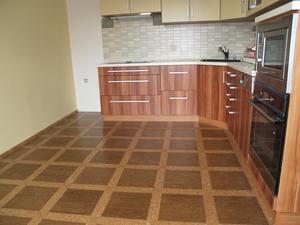 Linoleum - can be both natural and artificial. It has a different color scheme, including imitating various coatings. At a price much cheaper than the rest, especially linoleum made of artificial material. This coating is easy to clean, has a good heat and sound insulation. Available with or without insulation.
Linoleum - can be both natural and artificial. It has a different color scheme, including imitating various coatings. At a price much cheaper than the rest, especially linoleum made of artificial material. This coating is easy to clean, has a good heat and sound insulation. Available with or without insulation.
You can handle the installation yourself, without resorting to the help of a specialist. Will last with proper care about ten years. When buying, you must look at the marking - it indicates where it is allowed to lay this material.
When choosing any floor covering, do not forget about environmental friendliness, our health depends on it.
The kitchen floor is subject to the most wear and tear of all the rooms in a house or apartment. The owners want the floor in the kitchen to be easy to clean, so that the floor is resistant to damage, not afraid of spilled water, oil or grease. It is not so easy to decide which floor is better to make in the kitchen so that it meets all the requirements at once. So let's try to figure out what you need to pay attention to when equipping the floor.
Before you make a floor, you need to make sure of a few things, firstly, think about how the interior design of the room and the future floor are combined. Secondly, you should check whether the base is ready for the floor, which should be perfectly flat and horizontal, you may have to redo the screed.
This is important, the quality of the base depends on the duration of the floor itself, so in case of uncertainty, it is better to consult an expert.
In addition, there may be technological limitations, for example, if you intend to equip the kitchen with underfloor heating, you should also use an appropriate floor covering with high thermal conductivity. In this case, it is better to choose a coating from the options recommended by experts for each situation.
If the kitchen is large or combined with a room, they practice such a solution as a combination of floor coverings of several varieties. For example, lay porcelain stoneware or tiles in the working area, and make a laminate floor or lay linoleum in the dining area. If the kitchen area is small, then it is wiser to use the same material for the entire floor, preferably a solid color.
Ceramic tile
Among the varieties of kitchen flooring, tile is the most popular option. Affordable, ceramic tiles have beauty that is durable, and as a coating, tiles are very practical to use. This material is not afraid of moisture, absolutely clean from the point of view of ecology, resistant to sunlight and various liquids.
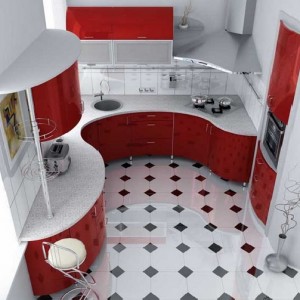
In addition, thanks to the variety of patterns or ornaments, a large range of colors, you can choose the right tile for any design designed for the kitchen. Various patterns are often laid out from tiles of several colors.

There are several basic ways of laying ceramic tiles: run-up, butt-to-butt, diagonally. You can also combine all these methods. It should be noted that the tile also has disadvantages, the most significant: the tile is cold, such a floor will have to be covered with a rug or a heated floor should be installed in the kitchen.

Where the hostess works, it is better to lay tiles with a matte finish, with a relief surface, your feet slide much less on such tiles, thereby you will protect yourself from the danger of falling on a slippery floor and getting injured. For the kitchen, it is recommended to lay wear-resistant tiles on the floor (wear resistance class 3-4, hardness class 4-5).
The artificial material porcelain stoneware is known to specialists for a number of advantages. Due to the ability to withstand extreme temperatures, strength, moisture resistance and high hardness (hardness grade 8-9), porcelain stoneware looks like the perfect flooring for the kitchen.

If you choose from varieties of porcelain stoneware, then for the kitchen it is preferable to take polished tiles rather than matte ones.
Self-leveling floors
Polymer self-leveling floor (the so-called liquid linoleum), spreading over the surface of the screed and after curing forming an excellent coating. This floor has a spectacular look, smooth, shiny, you can choose from dozens of color options. But they also make fantastic-looking self-leveling floors with a three-dimensional pattern. In such a 3D floor, beautiful paintings, photographs or decorative elements (plastic, metal, wooden inserts) are used.

The advantage of such a floor is moisture resistance, high resistance to mechanical damage and wear resistance. But you should keep in mind that such a floor is glued to the screed “tightly” and changing or removing this coating will be a big problem.
Concrete floor
Waxed concrete flooring is something ultra-modern, urban. Making such a floor is one of the examples of high-tech design. Naturally, in terms of strength and durability, this flooring is ideal. But the concrete floor is cold and very heavy, so you need to consider how much weight is added to the load on the supporting structures of the building.
Linoleum in the kitchen
A very common flooring option that people think about when deciding which floor to make in the kitchen is linoleum. Both natural and synthetic linoleum is practical to use, and artificial linoleum, with its excellent performance, is also inexpensive.

Modern linoleum has gone far from the old Soviet samples, the times of the USSR. This is a beautiful and durable polymer material, with high sound and heat insulation, which will last at least ten years without any problems. For the kitchen, it is better to choose semi-commercial linoleum - it has a thicker protective layer, which means it is more durable.
Linoleum on the floor in the kitchen is good for everyone, it is easy to lay even on your own, it is easy to clean and does not need special care. Thanks to a large number of colors, patterns, linoleum patterns, you are in no way limited in your search for kitchen design options. There is linoleum for wood, parquet, leather, stone and with abstract patterns.

But keep in mind that synthetic linoleum is not always safe for health. In order not to spoil the environment in the room, avoid buying cheap linoleum sold in the markets. Linoleum with a large amount of harmful impurities produces a strong unpleasant odor from the roll.
There are types of linoleum that cannot be used in residential premises. Therefore, carefully read the contents of the markings on the linoleum and labels. It says where you can use this linoleum. The safety for human health of the brands artoleum, marmoleum and other expensive linoleums is reliably known.
Although cork flooring is a novelty for consumers in Russia, many supporters of natural finishing materials have already appreciated this flooring. With a frequency of several years, the cork oak bark is cut off and a wonderful coating is made from it, very comfortable, elastic, protecting your spine when walking.

Cork floor is a warm floor, non-slip, soundproof and resistant to dust and stains, for rooms where there are asthmatics or people with allergies, cork is optimal.
It is widely believed that this material is very useful for the human body. In addition, cork looks great in almost any interior, thanks to a variety of shades and textures. So that the cork floor is not afraid of moisture, it is coated with a special varnish before use.
Wooden floor and parquet in the kitchen
Natural wood floor coverings, whether it is parquet or wooden flooring, although expensive, are the most luxurious. A kitchen with such a floor will look very respectable. This floor goes well with different interior styles. However, wood is vulnerable to moisture and temperature, so these floors are more suitable for a dining or dining area than a work area.

With the help of special impregnations and special varnishes, wooden floors are strengthened and made resistant to moisture, dust and mechanical damage.
In addition to the need for constant care, the disadvantage of wooden floors is the high cost of both the main material and additional materials and treatment and care products.
If your budget allows for these costs, you will get a floor that is ideal in terms of ecology and rich in design possibilities.
Use of laminate flooring in the kitchen
An acceptable alternative to wood flooring is laminate flooring. It is inferior to wood in terms of ecology, but it is significantly cheaper. The advantages of this coating include ease of installation, low flammability, resistance to stress and mechanical stress.
It is important that the laminate can be laid on an equipped warm floor. This coating is available with a large number of patterns, wood, marble, tile or natural stone. The disadvantage of this material is low moisture resistance. Therefore, even if you bought a waterproof option, anyway, take care of waterproofing during installation.
Buy material from reputable sellers who have long been known in the building materials market. Do not forget to check for which premises this type of laminate is specifically intended, and do not hesitate to ask the seller for product certificates: conformity and hygienic.

Thus, in the process of choosing which floor is best for the kitchen, you will have to find a balance between two groups of factors. On the one hand - beauty and naturalness, and on the other - strength and durability. Although flooring manufacturers themselves strive to offer the best combination of these important qualities.



